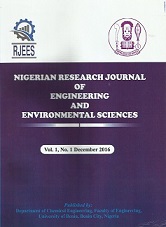INTERPRETATION OF POLE – DIPOLE 2-DIMENSIONAL GEOELECTRICAL RESISTIVITY SURVEY DATA USING BLOCKY AND SMOOTHNESS CONSTRAINED INVERSION METHODS
Authors: *Alile O.M, Aigbogun C.O, Airen J.O, Ighodalo J.E, Eguavoen K
DOI Info: N/A
ABSTRACT
The interpretation of 2 – Dimensional geoelectrical resistivity data in the field at Ekiugbo, Uhunmwode LGA, Edo State, Nigeria was carried out using the smoothness constrained and blocky inversion codes. This was aimed at identifying the areas of application of these interpretation techniques. Pole-dipole array method was used for the transverse in acquiring the data. The survey spanned a transverse of 300 m. In order to obtain a 2-D model of the subsurface, the field data were inverted using the RES2DINV software. From the inversion it was observed that the smoothing of model resistivity inversion method is suitable for areas with smooth variation of subsurface resistivity while the blocky inversion method is best suited for areas with sharp interfaces or boundaries between different regions with different resistivity values.
Affiliations: Department of Physics, Faculty of Physical Sciences, University of Benin, Benin City, Edo State, Nigeria
Keywords: Blocky, Inversion, Smoothness Constrained, Resistivity, Tomography
Published date: 2017/06/30









